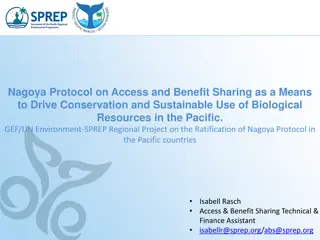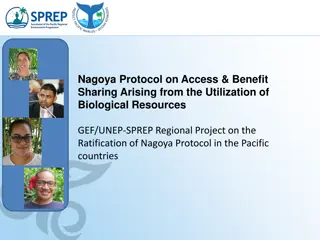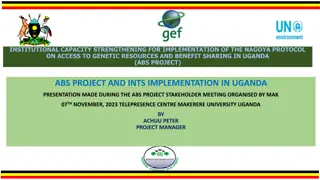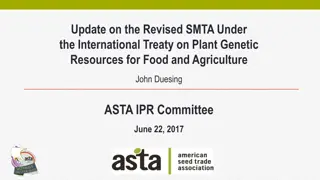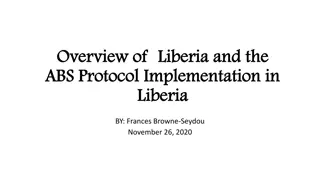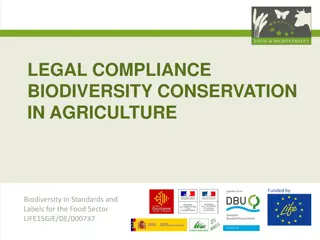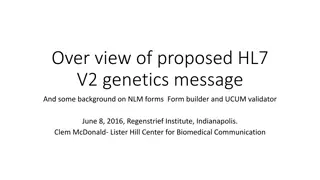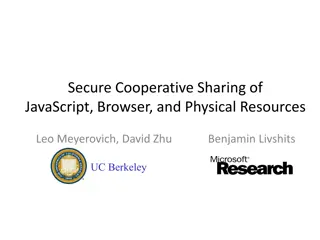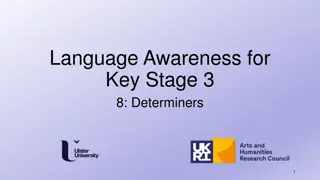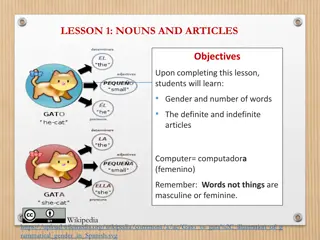Understanding the Key Articles of the Nagoya Protocol on Access to Genetic Resources and Benefit-Sharing
The Nagoya Protocol aims to promote fair sharing of benefits from genetic resources utilization for conservation efforts. It encompasses access, technology transfer, funding, and respect for rights over resources and technologies. The protocol applies to genetic resources, traditional knowledge, and associated benefits, excluding human genetic resources and commodities. It promotes cooperation among nations and is harmonized with other international agreements. Exceptions exist for specialized instruments like the International Treaty on Plant Genetic Resources for Food and Agriculture.
Download Presentation

Please find below an Image/Link to download the presentation.
The content on the website is provided AS IS for your information and personal use only. It may not be sold, licensed, or shared on other websites without obtaining consent from the author. Download presentation by click this link. If you encounter any issues during the download, it is possible that the publisher has removed the file from their server.
E N D
Presentation Transcript
Botanic Gardens Conservation International The world s largest plant conservation network Module 3: Key Articles of the Nagoya Protocol on Access to Genetic Resources and Benefit- Sharing People Places Plants Science
Objective (Article 1) The objective of the Nagoya Protocol is: the fair and equitable sharing of benefits arising from the utilisation of genetic resources, including by appropriate access to genetic resources and appropriate transfer of technologies, taking into account all rights over those resources and to technologies and by appropriate funding, thereby contributing to the conservation of biological diversity and the sustainable use of its components
Analysing the Objective To break this down into component parts, the objective of the Nagoya Protocol is: to share benefits arising out of use of genetic resources, as a means to contributing to the other objectives of the Convention on Biological Diversity (CBD) conservation and sustainable use. Meeting this objective necessarily involves appropriate access to genetic resources by users as well as appropriate transfer of relevant technologies to providers . In this regard, recognition must be given to all rights over genetic resources and to technologies. In addition, funding from the public and private sector must be provided in ways that are again appropriate .
Scope (Article 3) The Nagoya Protocol applies to: Genetic resources within the scope of Article 15 of the CBD Traditional knowledge (TK) associated with those genetic resources Benefits arising from the utilisation of genetic resources and associated TK
Scope Exclusions and Exceptions The Nagoya Protocol does not apply to human genetic resources. It is also not designed to apply to commodities its focus is on research and development. Because the Protocol (and the CBD) is based on countries sovereign rights, it does not clearly apply to genetic resources in areas beyond national jurisdiction such as the high seas although there are ongoing talks on this issue. The Nagoya Protocol is intended to be implemented in a mutually supportive manner with other relevant international instruments. It does not apply to certain genetic resources in particular circumstances when there is a specialised ABS instrument that is supportive of the CBD, for the Party or Parties to that specialized instrument in respect of the specific genetic resource covered by and for the purpose of the specialised instrument. For example, the Protocol does not cover genetic resources from a species listed on Annex 1 of the International Treaty on Plant Genetic Resources for Food and Agriculture when, and only when, they are being used for those specific food/feed purposes by a user in a Party to the ITPGRFA.
Use of Terms (Article 2) Utilisationof genetic resources is defined as: to conduct research and development on the genetic and/or biochemical composition of genetic resources, including through the application of biotechnology Biotechnologyis defined as: any technological application that uses biological systems, biodiversity, living organisms or derivatives thereof, to make, modify products or processes for specific use Derivativeis defined as a naturally occurring biochemical compound resulting from the genetic expression or metabolism of biological or genetic resources, even if it does not contain functional units of heredity
Scope unanswered questions However, these articles leave several questions unanswered, such as: What about genetic resources acquired prior to the NP and/or the CBD, but utilised after the NP comes into force? This is a major issue for botanic gardens that hold historic ex situ collections. It remains to be seen how this area of uncertainty will be handled, but it is likely that some countries will attempt to include new utilisation of genetic resources and associated traditional knowledge accessed before the NP and/or the CBD in their access legislation. What work carried out by botanic gardens is covered by the definition of utilisation ? Given scientific developments, it is unclear how the concept of a functional unit of heredity will be interpreted and what activities undertaken by gardens will be considered utilisation as defined in Article 2. DNA barcoding, some taxonomic and phytochemical research and selective breeding may be covered, while some propagation and ecological studies might not be covered. It is important for gardens to ensure they comply with terms and conditions set out in provider countries access legislation.
Access (Article 6) Parties can decide whether or not to require prior informed consent for access to genetic resources in their national boundaries. However, if Parties to the Protocol do decide to require consent for access, they must follow the detailed access standards laid out in Article 6, and set up ABS legislation that: provides legal certainty and transparency provides for a written decision by the competent national authority in a cost-effective manner and within a reasonable period of time provides information on how to apply for prior informed consent sets out criteria for obtaining prior informed consent or approval and involvement of indigenous and local communities provides evidence (a permit or equivalent) of the decision to grant prior informed consent and the establishment of mutually-agreed terms
Simplified access for non-commercial research (Article 8) The Nagoya Protocol does take an important step in Article 8(a): it provides that Parties shall create conditions to promote and encourage research which contributes to the conservation and sustainable use of biodiversity, including through simplified measures on access for non-commercial research purposes, taking into account the need to address a change of intent for such research. This article represents a very positive development for botanic gardens, whose work is important to supporting conservation and sustainable use. However, the introduction of simplified access measures requires botanic gardens to have measures in place to address any change of intent from non-commercial to commercial research.
Benefit-sharing (Article 5) Under the Nagoya Protocol, benefits arising from the utilisation of genetic resources as well as subsequent applications and commercialisation shall be shared: fairly and equitably with the provider Party (the country where plants are accessed) upon mutually agreed terms and with indigenous and local communities where appropriate Benefits may include monetary and non monetary benefits (a list of some possible benefits is included in an Annex to the NP).
Global Multilateral Benefit-Sharing Mechanism (Article 10) Parties have also been asked to consider the need for and modalities (how it would work) of a global multilateral benefit-sharing mechanism. Discussions are yet to begin but such a mechanism could involve the collation of financial benefits for wider distribution. This funding model could enable benefit-sharing from the utilisation of genetic resources and associated TK found in transboundary situations, or where prior informed consent could not be obtained. Depending on the direction of the discussions, this article may become very relevant for botanic gardens and other ex situ collections holding such material.
Compliance (Articles 15, 16 and 17) Compliance by users of genetic resources is at the core of the Nagoya Protocol. Parties to the Protocol must introduce measures at a national level: to ensure genetic resources and associated traditional knowledge utilised within their jurisdiction have been legally accessed to address situations of non-compliance to monitor utilisation through designating one or more checkpoints to collect or receive information on PIC, MAT, the source of the genetic resources and/or utilisation
Monitoring utilisation: checkpoints and certificates Checkpoints will provide information to the relevant national authorities, the Party providing PIC and the ABS Clearing House, as appropriate. Parties will decide what checkpoints to set up. As set out in Article 6 on access, Parties requiring PIC will also provide for the issuance of a permit (or equivalent) to serve as evidence that the genetic resources it covers have been accessed in accordance with PIC, and that MAT have been established as required by the provider Party. This permit will constitute an internationally-recognised certificate of compliance and can be used at checkpoints. The certificate will contain certain minimum information, such as: issuing authority; date of issuance; provider; person/entity to whom PIC was granted; material covered by the certificate; confirmation that PIC was obtained and MAT were established; and whether commercial and/or non-commercial use was agreed. This flow of information will be crucial for ensuring genetic resources are accessed and utilised according to PIC and MAT of the providing country.
Associated Traditional Knowledge Traditional Knowledge associated with genetic resources is to be accessed with the prior and informed consent or approval and involvement of Indigenous and Local Communities (ILCs) that hold associated Traditional Knowledge (TK): Parties shall take measure so that benefits are shared fairly and equitably with ILCs that hold the associated Traditional Knowledge Parties (to the Protocol) should take into account ILCs customary laws and community protocols Parties should work with ILCs to establish mechanisms to inform potential users Parties should support development by ILCs of protocols, minimum requirements for MAT, model clauses for benefit-sharing Parties should not restrict the customary use and exchange of genetic resources and associated TK within and between ILCs Parties need to address non-compliance with national measures on access and benefit-sharing for associated TK
Model contract clauses and codes of conduct (Articles 19 and 20) The Nagoya Protocol recognises that different users of genetic resources (e.g. botanic gardens) may access and utilise genetic resources, and share benefits, quite differently. It encourages the development, update and use of sectoral and cross-sectoral model contractual clauses, and voluntary codes of conduct, guidelines and best practices and/or standards. The Nagoya Protocol s governing body the Conference of the Parties serving as the Meeting of the Parties to the Nagoya Protocol will take stock of the use of these measures, and may consider the adoption of specific codes of conduct, guidelines and best practices and/or standards. These articles present a good opportunity for botanic gardens to develop realistic and useable models and standards for use in their sector. Module 6 provides more detail on model agreements and codes of conduct.
Information sources (Articles 13, 14 and 17) The Protocol provides for several ABS information sources and authorities, at national and international levels. At the national level, each Party must designate: a national focal point on ABS, to make information available on procedures for obtaining PIC, national access legislation, and national authorities, indigenous and local communities and stakeholders one or more competent national authorities, responsible for granting access or issuing evidence that access requirements have been met, and advising on procedures for gaining PIC and establishing MAT One or more checkpoints to collect and receive information from users relating to PIC, MAT and utilisation of genetic resources
The ABS-CH (Article 14) At the international level, the ABS Clearing House (ABS-CH), maintained by the Secretariat of the CBD, will provide and share information on national ABS measures and authorities, internationally recognised certificates of compliance and other ABS measures such as codes of conduct and model agreements. Parties have obligations to make information required by the Protocol available to the ABS-CH. As such, the ABS-CH will be crucial to NP implementation: it will act as the major source of legal certainty and information and play a critical role in the monitoring of utilisation of genetic resources.
End of Module Three (Key Articles of the Nagoya Protocol Explained) Why not try the quick quiz? Then, please go to Module Four (Practical Implementation for Botanic Gardens)
Connecting People Sharing Knowledge Saving Plants Our Mission is to mobilise botanic gardens and engage partners in securing plant diversity for the well-being of people and the planet Descanso House, 199 Kew Road, Richmond, Surrey, TW9 3BW, UK www.bgci.org @bgci



